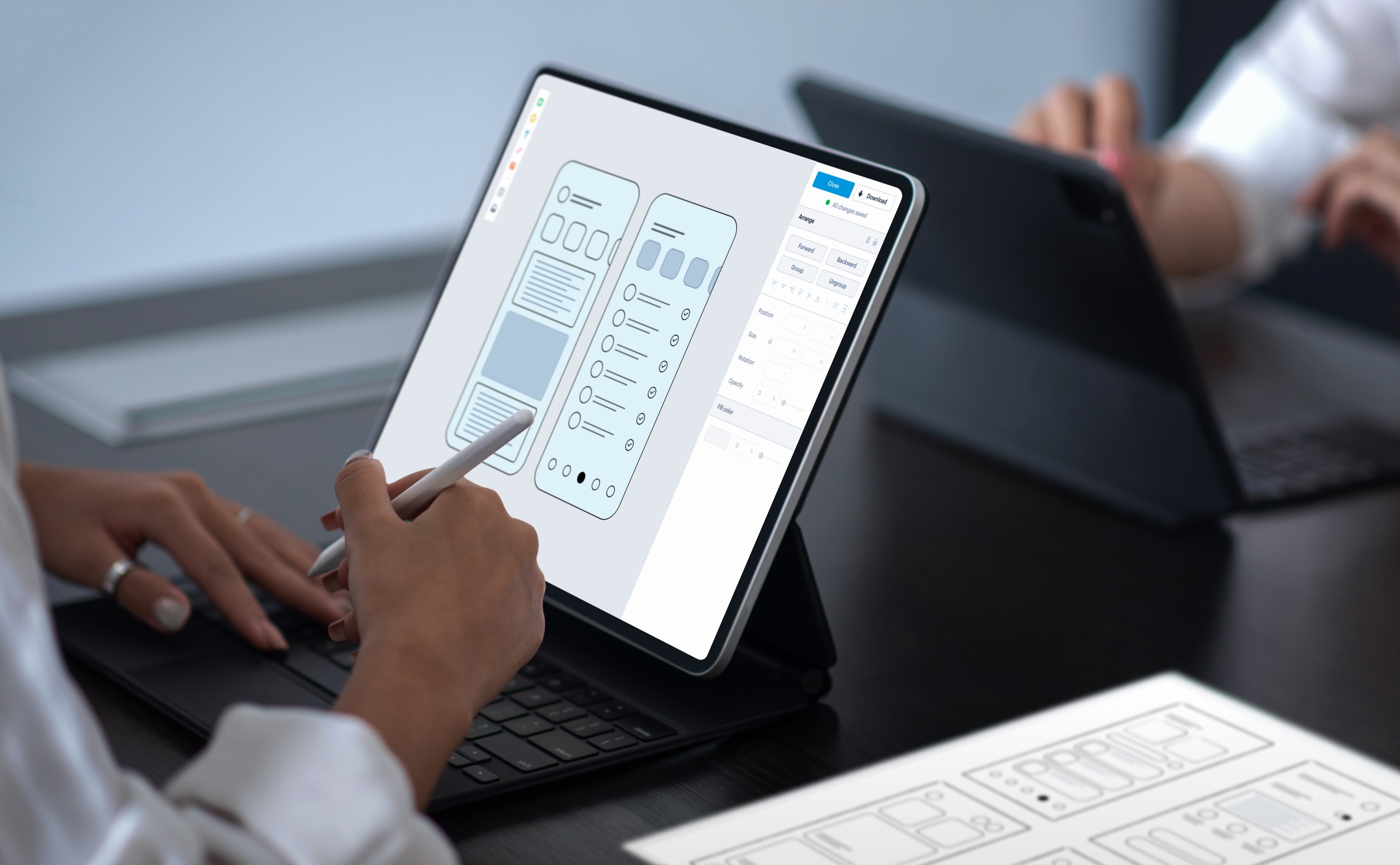Website Development Process in 6 Steps: A Step-By-Step Guide

Developing a website can seem like a daunting process, with many steps and phases involved before launching a finished product. This complete guide breaks down each phase of the website development process, from initial planning to the final launch and beyond. Whether you're looking to create your first website or improve an existing one, understanding these web development stages and best practices is key to success.
What Is Website Development?
Before diving into the step-by-step process, let's start with the fundamentals: what is website development? At a high level, website development refers to the creation of an online presence and set of web pages for a brand, business, or individual. It encompasses everything from website architecture, design, and content creation to backend coding and technology integration.
The goal is to develop an engaging, functional website aligned with business and user needs. The actual web development process follows a strategic path to set up, design, build, and ultimately launch the site for public access. Following proven systems for web development life cycles allows you to methodically plan, implement, test, and improve your site over time.
Scope of Website Development
Web development has become a cornerstone of the digital era, witnessing remarkable growth. The field of software development methodologies encompasses front-end development for designing user interfaces, back-end development for server-side functionalities, and full-stack development that combines both. This growing focus has led businesses to rely on front end development services to build responsive, user-friendly, and visually consistent digital experiences. With the rise of technologies used in web development like React and Angular for the front-end, and Node.js and Django for the back-end, developers now have versatile tools to create dynamic and feature-rich websites.
As businesses increasingly rely on online platforms, many are choosing to hire web developers to meet the growing demand for skilled digital expertise. The ever-evolving internet landscape ensures that the scope of web development remains expansive, offering continual opportunities for innovation and creativity.
Overview of Website Development Life Cycle
The website development life cycle consists of several standard phases which work together to make a website, from the initial concept to the final product. They include:
1. Planning: Defining project goals, requirements, content strategy, and sitemaps
2. Design: Creating the visual layouts and aesthetic
3. Build/Development: Coding the frontend and backend systems
4. Testing: Ensuring functionality across devices and browsers
5. Launch: Pushing the site live for public access
6. Post-launch Review: Gathering feedback for ongoing optimisation
Understanding the steps to develop a website helps set clear expectations. The specific steps within each phase may vary based on business needs and the complexity of the project vision. A basic 5-page site will have simpler requirements than a robust web application or e-commerce store with dynamic features.
Now let’s explore each website development step in more detail:
What Are the Website Development Phases?
Developing a website strategically means understanding the process phases website builders follow. Standard website development steps involve six key phases:
Phase 1: Planning
The planning phase lays the strategic groundwork for any development project. This web development step is focused on defining goals, priorities, requirements and information architecture:
1. Define business/user goals: What purpose will this website serve? Key goals could include generating leads/sales, providing info, enabling bookings etc.
2. Conduct user research: Gain insights into your target audience through surveys, interviews, and persona creation.
3. Map out requirements: What pages, features, integrations etc. will be needed to meet site goals?
4. Plan out content and site architecture: Develop content strategy, site maps, and flowcharts based on priorities.
Solid planning ensures your website will contain the right pages, features and messaging to support desired goals. It also helps shape realistic timelines and budget needs before the design and development begin.
Key Planning Deliverables:
- Project goals/business case
- Target audience profiles
- Content strategy
- Technical and functional specifications
- Site maps/flowcharts
Phase 2: Design
With requirements gathering and planning complete, the website architecture design phase focuses on bringing the vision to life visually. Your web design agency will use the approved planning materials to architect the site's look, layout, UX and workflows.
1. Define visual branding: Colour schemes, fonts, and imagery to use in page layouts
2. Develop wireframes/mockups: Low fidelity sketch layouts; High fidelity visual comps
3. Design core pages: Homepage drafts, content page templates, graphics
4. Refine UX flows: Ensure ease of navigation between pages
This web design process shapes how visitors will experience and interact with all areas of your website. It leads directly into the development workflow for engineering the frontend to backend build.
Key Design Deliverables:
- Branding guidelines
- Wireframes
- Page templates/mockups
- Graphics/media assets
- Style guide documentation
Phase 3: Development
With designs approved, the development team takes over coding the custom frontend and backend builds. This complex stage of web development requires creative engineering, contemporary web development technologies, and problem-solving ability to construct a fast, dynamic, fully functioning site.
1. Program site architecture: Configure hosting, and content management systems
2. Integrate 3rd party tools: Connect any APIs, plugins, and payment systems per plan
3. Frontend build: HTML markup, CSS, Javascript/libraries like React or Angular
4. Backend build: Server-side code in languages like PHP, Ruby, Python
5. Database structure: Develop efficient data models
6. Admin portal creation: Enable clients to manage content
The goal is to skillfully develop all pieces – design templates, forms, databases, security, caching etc, – into an optimised website app.
Key Development Deliverables:
- Hosting setup
- Custom CMS framework
- Source code
- Configured databases
- Integrations
- Testing credentials
Phase 4: Quality Assurance Testing
Quality assurance is a key step in developing a website. Before officially launching any website, rigorous testing is crucial.
1. Functionality testing: Validate that all pages, integrations, forms, and links fully work
2. UI/UX testing: Ensure intended workflows and ease of use
3. Cross-browser reviews: Check compatibility on all modern browsers
4. Speed optimisation: Leverage tools like PageSpeed Insights and Lighthouse
5. Security checks: Penetration testing, SSL implementation
6. Responsiveness testing: Validate mobile, tablet, and desktop experience
7. Accessibility: Ensure compliance with ADA standards
Thorough testing enables identifying any defects, weaknesses or issues missed during build phases. Your development team can then resolve them promptly before open access.
Key Testing Deliverables:
- Signed off verification of all functional elements
- Performance data/scores
- Documented issues resolution
Phase 5: Launch
Once thoroughly tested, planned launch activities kick-off:
1. Migrate content: Upload all pages, blog posts, and products as needed
2. Setup analytics: Connect Google Analytics and tag manager
3. Configuring SEO: Ensure metadata is optimised on all pages
4. Enable security: Install firewalls, and malware protection
5. Soft launch: Limited release to gather initial feedback
6. Official launch: Broader release including marketing promotion
7. Post-launch monitoring: Overseeing performance and monitoring for urgent issues
Carefully orchestrating both technical and marketing launch plans leads to an effective website release.
Key Launch Deliverables:
- Completed content migration
- Implemented analytics/SEO
- Launch marketing schedule
- Press releases
Phase 6: Post-launch Review & Optimisation
Website development doesn't end at launch. To evolve alongside emerging technologies and user expectations, you must continually optimise your site post-release:
1. Evaluate analytics: Review visitor traffic, engagement metrics, and goals data
2. Gather user feedback: Conduct surveys and user testing to identify areas for improvement
3. Expand features: Release enhancements as per product roadmap priorities
4. Review tech stack/hosting: Assess innovations like headless CMS, and cloud infrastructure
5. Conduct SEO audit & speed optimisation: Audit keyword opportunities, technical SEO health, and improve performance through image compression and code optimisation
6. Enhance design: Refresh page templates and new branding
7. Boost security: Update protocols to address new threats
8. Fix bugs: Patch newly identified defects rapidly
Regular optimisation is key for increasing traffic, leads, and sales over the long-term life of your website.
Key Post-launch Deliverables:
- Updated analytics dashboards
- Quarterly performance reports
- Ongoing release notes on fixes and enhancements
Key Roles Involved in Web Development Projects
Successfully executing all phases of the website development process relies on cross-functional collaboration between different specialist roles:
- Project Manager: Leads planning, budgeting, timelines, and communication
- Business Analysts: Captures scope, requirements, and business logic
- UX/UI Designers: Conduct research, design site architecture, templates, and prototypes
- Web Developers: Engineers frontend code (HTML/CSS/JS) and backend (PHP, Python etc.)
- DevOps Engineers: Manages hosting infrastructure, CI/CD pipelines, security
- Quality Assurance: Performs extensive testing before releases
- SEO Strategists: Optimises page content, metadata and linking for discoverability
- Marketing: Drives launch promotion and traffic growth strategies
Assembling the right website development team, including both internal staff and external consultancies, ensures all areas of expertise are covered throughout an initiative’s duration.
Choosing the Right Web Development Company
Given the many complex moving pieces encompassing the web application life cycle, most businesses hire an expert web development company rather than relying solely on in-house resources. The right partner can bring forward-thinking design and proven technical chops for taking websites from concept to high-performance reality.
When vetting website development firms, ensure evaluating their core capabilities around:
Design Expertise
Proven track record architecting sites focused on conversion rate optimisation goals for your specific business vertical. Intricate knowledge of the latest UI/UX best practices. Expertise in branding, visuals, animations and dynamic content presentation.
Custom Development Chops
Engineering robust on-brand experiences through quality code. Using optimal tech stack tailored to project needs - open source and proprietary tools that scale. Extensive programming experience across frontend, backend, DevOps and databases for complex systems.
Industry Knowledge
The company should understand challenges, visitor expectations and technical considerations uniquely specific to your industry, whether that be SaaS, e-commerce, healthcare, real estate or otherwise. This enables the creation of highly customised experiences.
Security & Compliance
With data breaches on the rise, partnering with developers well-versed in web security protocols including penetration testing, infrastructure hardening and compliance considerations (PCI, HIPAA etc.) is key for risk mitigation.
Innovation
Finding an agency at the leading edge technically keeps your website continually evolving to leverage things like ML and AI, AR, voice search and more emerging technologies on the horizon. This ensures keeping experiences fresh longer-term.
Choosing web developers with proven experience, technical talent, innovation know-how and passion for your vertical leads to the most successful partnerships.

Custom Web Development Services
Creating solid digital presence and enhancing brand value through web-based products
Partnering for Successful Website Development
As highlighted throughout this guide, comprehensive website development leveraging industry best practices is key to crafting an effective online presence. For over 11 years Webandcrafts, the leading digital transformation company has helped leading brands bring innovative visions to life through custom design, development and deployment services. Our award-winning work scales from small business sites to intricate enterprise web apps. If you’re looking to enhance the visual appeal and usability of your website, you can also hire a web designer from WAC to create modern, user-focused interfaces that elevate the overall experience
Interested to learn more? Let's chat about your website goals and how our expertise can help achieve them. Schedule a free 20-minute consultation through our website now.
Webandcrafts offers website development services in India, specializing in eCommerce development, web design, mobile application development, and digital marketing. We are committed to providing the best services to our customers meeting industrial and business standards. If you have any queries on eCommerce development, contact us right away.
FAQs
- Planning - Define strategy, requirements, and content
- Design - Create layouts, and templates
- Development - Code custom frontend and backend
- Testing - Validate functionality, UI/UX, and responsiveness
- Launch - Deploy the site publicly and promote
- Post-Launch Maintenance - Continual improvements
Discover Digital Transformation
Please feel free to share your thoughts and we can discuss it over a cup of tea.









